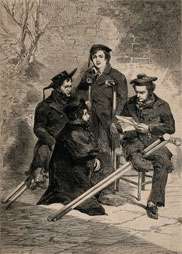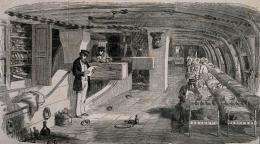Wounded sailors convalescing at Haslar Naval Hospital, Gosport (Crimean War). Credit: Wellcome Library, London
The British Empire depended on its navy to survive and grow. For its operational success, the Royal Navy in turn depended on the health of its sailors, who were frequently exposed to ‘exotic’ and dangerous new infections. At the University of Oxford, a team of researchers are exploring naval health in the 19th century and the contribution of naval officers to Victorian medicine. By Penny Bailey.
The British Royal Navy carried some of the contradictions of Victorian morality, along with its reforming zeal, to distant climes. In 1845, on a mission to West Africa to suppress the slave trade (very recently abolished in Britain in 1838), a British naval vessel, the 'HMS Eclair', docked at Freetown in Sierra Leone to take on supplies.
Once the ship left the port, large numbers of the crew began to die from what was probably yellow fever. The chances of getting home with such a depleted crew looked slim, so the ship headed to Boa Vista, one of the Cape Verde Islands. Perhaps somewhat disingenuously, the crew reassured the Portuguese authorities that although there were many sick people onboard, they didn't have yellow fever, and it wasn't contagious. They were allowed to dock, and shortly afterwards an epidemic of yellow fever erupted on the island, killing a third of its inhabitants.
Amid demands for compensation from the Portuguese government and hasty action by governments around the world to strengthen quarantine procedures for incoming vessels, the Admiralty and Portuguese doctors carried out several highly charged epidemiological investigations of the outbreak.
"Issues of contagion and quarantine, and epidemiology, how diseases spread, were critical to international medical debates at the time," says Professor Mark Harrison, Director of the Wellcome Unit for the History of Medicine at the University of Oxford. He and his colleagues at the Unit have been awarded a Wellcome Trust programme grant to study naval health and medicine in the Victorian period.
"Naval medical officers, MOs, played a crucial role in these debates, which were often very fierce and bitter," he says. "Because it was a very, very controversial topic. It didn't just involve medical reputations. There were many political and economic ramifications. The workings of the Empire, international relations, international trade, depended upon whether or not people thought a disease such as yellow fever, or cholera, was transmissible, whether it could be carried by ships, or by railway passengers."
Interior of sickbay, HMS Belleisle, Crimean War. Credit: Wellcome Library, London
The Navy needed healthy crews to fulfil its operational requirements, and Professor Harrison and colleagues believe this was likely to have been a stimulus to innovation in medicine, fostering an experimental and empirical outlook among naval surgeons. "We hypothesize that a lot of surgeons in the navy were at the cutting edge of sub disciplines of medicine."
Naval surgeons - like army surgeons, but unlike their civilian counterparts - had the opportunity to observe fevers, like cholera, yellow fever, and malaria, in different parts of the world, in a variety of contexts, and to study their causes and behaviour. Again like the army surgeons, they had a strong tradition of pathological investigation and of correlating post-mortem findings with observations of the disease and its appearance in living patients.
The Navy's meticulous records of disease incidence also put them at the forefront of the emerging discipline of epidemiology. "They compared the death rates on different naval vessels, or on land, then tried to account for the factors which may have contributed to a disease outbreak in one location, but not another. They were modelling disease, looking at its statistical patterns of spread."
Cholera was a huge problem in the Crimean war, and naval MOs tried to work out how it behaved and spread. "Water does come up sometimes for consideration as a possible cause, but very often people would attribute it to person-to-person contagion. Or to filthy conditions on a vessel. Or to land winds that may be blowing across a cholera infected area, carrying the seed or the 'germ' to a vessel moored in the Black Sea."
Royal Navy surgeons were also looking at ways to treat - and preferably prevent - these mysterious new 'imperial' diseases. They pioneered the use of quinine, an effective treatment for malaria, as a prophylactic during the Niger Expedition of 1841 (another mission to suppress the slave trade). Although some skeptical naval and other practitioners noted (correctly) that as a prophylactic it was of limited use, many maintained the myth of its efficacy. "It was a way of encouraging people to sign up to the army and navy, and go out to the Tropics, which had a pretty bad reputation, deservedly in most respects, by reassuring them they would be protected from malarial fevers."
The work of the naval MOs on fevers and epidemiology was regarded as significant internationally, and they were prominent in organisations like the Royal Epidemiological Society.
Cabin fever
Back in Britain some of the general public were less impressed, viewing naval and other vessels as importers of exotic and sinister new diseases. Cholera reached Britain (having originated in India) in 1831 - and there was an outbreak of yellow fever (brought on a cargo vessel carrying copper ore from Cuba) in Swansea in 1865.
The resentment was fuelled by a lax and inconsistent quarantine system in the 1840s and 1850s. Ships were often quarantined for just a day or so, and riots broke out in some of the larger English ports like Southampton when sailors disembarked from vessels that appeared to have some disease onboard.
Those sailors who were quarantined for a significant period may well have died as a result. The 'HMS Eclair' lost more of its crew, including the ship's surgeon, to yellow fever on its way home from Boa Vista. Arriving at the Portuguese island of Madeira, the sailors applied (somewhat optimistically) for permission to dock. This time the Portuguese authorities refused. However, an English naval surgeon who was stationed on the island, Sidney Bernard, offered his services as ship's surgeon at considerable personal risk.
Back in Portsmouth, the 'Eclair' was sent on to the Quarantine Station at Stangate Creek in the Medway. Five more men died there, including Sidney Bernard, perhaps because the infected mosquitoes were able to breed in the heat below deck generated by the steam engine. Ironically, had the crew disembarked they may have escaped infection.
Sidney Bernard became a martyr and a hero in the British press. His death, and the heroism of another naval surgeon, James Ormiston MacWilliam (who lost most of his crew and captain to yellow fever on the 1841 Niger expedition and piloted the vessel back down the river himself) began to draw attention to the plight of the navy.
"In the 1830s, 1840s it was very common for Royal Naval vessels to come back to Britain with only half or less of their crew, due to yellow fever or some other disease," says Professor Harrison. "And it's the West Africa service which draws attention to this." Yellow fever became a cause célèbre in the 1840s and 1850s and sailors become objects of pity for the first time. "Before that they were pretty much ignored or vilified by the public as being drunkards and rough and ready. They were put upon a pedestal when they fought in battle, but then forgotten about soon afterwards."
Reform-minded sections of the British public - their sympathy strengthened by the Navy's humanitarian role in suppressing the slave trade - began to liken quarantine to locking people up in a house that was on fire.
"People began to say, we're putting all this effort into trying to rescue slaves from the vessels of other powers, operating along the African coast, yet our own sailors are being treated in some ways worse than slaves." This chimed with a popular sentiment growing in Britain at the time, appearing in Charles Dickens' 1844 novel, 'Martin Chuzzlewit', that 'charity begins at home'.
From the 1840s, after years of apparent indifference, the health of sailors and practice of quarantine came under close scrutiny. Naval MOs aligned themselves with parliamentarians and humanitarians campaigning for public health reform. These included members of the free-trade lobby, who opposed quarantine because it interrupted trade, and those lobbying for the repeal of the corn laws (preventing cheap foreign imports of cereals in order to maintain higher British prices).
This conjunction of interests, says Professor Harrison, served as a platform for the reform of naval health. It also underpinned the growing influence of naval MOs in British medicine and public health - and possibly even in wider social reform.
The navy's transition from sail to steam power in the era allowed MOs to draw analogies between conditions on board ship and in the new industrial workplace at home. The heat and fumes below deck and on the factory floor presented new occupational health issues; naval MOs suggested these might be ideal incubating conditions for disease.
The new steam-powered, iron-clad ships produced dramatic changes in the naval dockyards at home where boiler-makers and engineers replaced the traditional riggers and carpenters. These were more hazardous jobs and created new types of injury. Dockyard workers (although not officially members of the navy) were treated in naval hospitals, such as Haslar in Portsmouth and Stonehouse in Plymouth.
"People were also coming forward for treatment for illnesses unrelated to their work, and for their wives and children," says Professor Harrison. "And we're finding that in many of these 19th-century dockyards, a kind of prototype or precursor NHS was growing, in addition to the Poor Law medical service, within the naval medical service."
The extent to which that was the case will become clearer over the next five years. The research is likely to provide a unique and visceral perspective on life (and sickness and death) in the Victorian navy, as well as on some of the tensions and complexities underlying the Victorian reforming movement.
Provided by Wellcome Trust






















